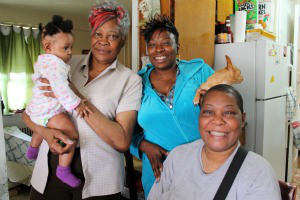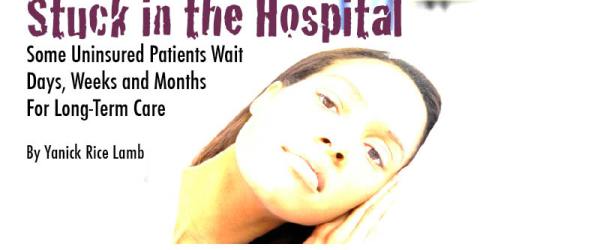 Samantha Hawkins marked the seasons of 2010 from a hospital bed at Montefiore Medical Center in the Bronx. She was admitted in the spring for 83 days, came out for two weeks in early summer, and returned for five and a half months spanning fall and winter. Finally, Hawkins went home for the holidays on Dec. 21. For her family, the homecoming was a Christmas miracle.
Samantha Hawkins marked the seasons of 2010 from a hospital bed at Montefiore Medical Center in the Bronx. She was admitted in the spring for 83 days, came out for two weeks in early summer, and returned for five and a half months spanning fall and winter. Finally, Hawkins went home for the holidays on Dec. 21. For her family, the homecoming was a Christmas miracle.
At times, her relatives thought she might not make it, said her mother, Lula Hawkins. They held her hands, praying and shoring up each other through one complication after another from kidney disease, congestive heart failure, diabetes and a mysterious inflammatory ailment finally diagnosed as sarcoidosis. “That’s when things started going downhill,” said her older sister, Gwen Cooper.
Hawkins has endured a 10-day coma, three mini-strokes, three bouts of pneumonia, plus surgery in August to implant a heart pump. Despite her list of ailments, part of what kept the 45-year-old stuck in the hospital was her lack of insurance.
Once upon a time, Hawkins had medical coverage as a housekeeper at a hospital in Westchester County, New York. After she left that job three years ago, she took out a policy on her own, but then the insurance company dropped her. When Hawkins ended up at Montefiore, weeks turned into months as she lay in a hospital bed with no way to cover her stay there or her next level of care. In the meantime, the hospital absorbed her bill while trying to help her find a way to pay for nursing care at her mother’s apartment or for long-term care at a facility willing to monitor Hawkins’ heart device.
Hawkins is one of a growing number of uninsured people who need long-term care after hospital stays. They lack insurance because they can’t afford it, their employers don’t offer it or they were dropped by private carriers after taking out policies on their own. Consequently, these patients experience delays in moving on to the next step in their care once they are medically ready for discharge. They are stuck in the hospital, because it’s hard to place patients in long-term care facilities or send them home with a nurse when they have no coverage, especially when there are complications. Hospitals end up picking up the tab — sometimes even after patients leave. Those costs are ultimately passed on to everyone who pays taxes and anyone who has a medical bill.
“The person is caught in the middle, because some facilities don’t want to take them,” said Carol Levine, director of the Families and Health Care Project at the United Hospital Fund in New York.
Hard-to-place patients make up a small, yet costly and time-consuming, portion of the U.S. hospital population. Uninsured hospital patients between the ages of 18 and 64 in need of long-term care increased 16 percent over the last five years, according to theAgency for Healthcare Research and Quality (AHRQ) in the U.S. Dept. of Health and Human Services (HHS). The number discharged to long-term facilities or supervised home-health care rose from 104,581 in 2005 to 121,173 in 2009.
Representatives from roughly a dozen hospitals from California to Massachusetts shared similar stories of trying to juggle not only the medical and financial needs of hard-to-place patients, but also family, housing and other issues.
In Chicago, Northwestern Memorial Hospital decided to rent a room for $500 a month so that a terminally ill patient with heart disease and no insurance could have a place to stay and receive hospice care. That was on top of the thousands of dollars for his hospital bill. The man, who was in his 40s and didn’t want to go to a nursing home, died two months later.
In Washington, D.C., an uninsured patient who experienced respiratory failure and complex surgery for an abdominal wound spent 104 days at Howard University Hospital. The hospital bore the cost of $1.3 million until it was able to transfer the patient to a nursing home.
“Everyone is experiencing the same sorts of issues,” says Stephanie Rennke, a physician who works specifically with the complex cases housed at the 26-bed Mount Zion Hospital down the road from the main facility of the University of California Medical Center in San Francisco (UCSF).
“This is a growing national problem,” said Barbara Ozmar, director of patient care coordination at Piedmont Hospital in Atlanta. “It’s huge, and it’s going to get bigger across the United States.”
This article was originally published at heartandsoul.com, which migrated to a different website. Click here for the version of the project that appeared in the June/July 2011 issue of in Heart & Soul magazine or here for an overview of the year-long project.
THE IMPACT ON PATIENTS
 Being uninsured can affect patients physically, emotionally, socially and, of course, financially. The lack of insurance is stressful and places patients at greater risk of medical bankruptcy — that’s if they can pay anything at all toward their hospital bills.
Being uninsured can affect patients physically, emotionally, socially and, of course, financially. The lack of insurance is stressful and places patients at greater risk of medical bankruptcy — that’s if they can pay anything at all toward their hospital bills.
The uninsured can afford to pay only 12 percent of their hospital bills in full, according to “The Value of Health Insurance,” a study released in May 2011 by the HHS Office of Health Policy. Patients without insurance had only $20 in financial assets on average, compared to $14,450 for the insured, the study said.
The 2007 Commonwealth Fund Biennial Health Insurance Survey also found that nearly half of working-age adults with no insurance had exhausted their savings and couldn’t cover basic necessities such as food, heat or rent.
But it’s more than finances.
Staying in the hospital longer than medically necessary can take a toll on patients. “The impact on the patient is much more than we can imagine,” Dr. Rennke of UCSF said.
“Being in the hospital can be an incredibly lonely experience for patients,” Dr. Rennke said. “They’re isolated from their families. They’re isolated from their communities. They feel a loss of independence.” Sleep deprivation is also an issue for some patients, she added.
Samantha Hawkins said that being away from her children, grandchildren, mother and siblings was the toughest part of being in the hospital despite regular visits. She also missed home cooking once she was able to eat solid food. “The hospital food was terrible,” Hawkins said. “I know it’s healthy, but it tasted like poison!” Each day, her mother brought her favorite meal: liver with onions, grits and green beans with potatoes.
As their stay goes on and on, hard-to-place patients might see fewer hospital workers rushing into their rooms. The sense of urgency subsides once they are considered stable and medically ready for discharge.
“If they were in a skilled nursing facility, they would be at the top of the list in terms of need,” acknowledges Anne Meara, R.N., associate vice president of network care management at Montefiore. “In our facility, if you’re here because you’re a discharge challenge, you’re a little bit lower on the list, because the staff is used to taking care of those with acute needs.”
However, the most serious consequence of delayed discharges is that patients face greater exposure to hospital-acquired infections like septicemia, a life-threatening, bacterial blood disease. Extended hospital stays also delay the time that patients can receive medical treatment or rehabilitation in a setting that might be better suited to their needs.
“A rehab facility can provide two to three hours a day of rehab,” explains Mark V. Williams, M.D., chief of the Division of Hospital Medicine at Northwestern University in Illinois. “A hospital is typically only going to have rehab capabilities for 30 minutes or so.”
“It’s a cost issue,” he adds. “Hospitals are not set up to conduct long-term rehab. They can’t provide that intensity of services for patients.” Dr. Williams noted that hospitals are typically paid one fee for a patient’s diagnosis over a period of time, not necessarily for the extra days and extra resources. “And so these patients end up costing significant amounts of money.”
THE COST OF STAYING
 Hospital bills for uninsured patients who need long-term care total at least $2.9 billion annually. Over the last decade, the average hospital bill for uninsured patients more than doubled. AHRQ figures show a 112 percent increase from $11,400 in 1998 to $24,140 in 2009 (compared to $28,204 for those who have insurance).
Hospital bills for uninsured patients who need long-term care total at least $2.9 billion annually. Over the last decade, the average hospital bill for uninsured patients more than doubled. AHRQ figures show a 112 percent increase from $11,400 in 1998 to $24,140 in 2009 (compared to $28,204 for those who have insurance).
However, a stay for an uninsured patient with circulatory problems is 42 percent higher than the current rate, averaging $34,317. It’s nearly four times as much for “multiple significant trauma” at $93,365 — hence the $1.3 million tab for the uninsured trauma patient at Howard University Hospital.
That’s why simply waiting it out in a bed that’s costing a hospital thousands of dollars a day isn’t necessarily the solution.
Although many people complain about being released from the hospital sooner than they would like, the new normal is staying in the hospital for as few days as possible with as few procedures as necessary.
“Hospitals are no longer a place where you stay until you get better and then go home,” said Barbara Ozmar of Piedmont Hospital in Atlanta. “The general public at large doesn’t fully appreciate that we get you well enough to transition your care.”
“Well enough” means stable and out of crisis. It can also mean that a patient will still be in pain at discharge and require medical devices, such as a ventilator, for the transition to long-term care at home or another facility. “We are able to keep very sick people alive nowadays in a variety of settings,” Meara points out.
Over the last two decades, U.S. hospitals have reduced the average length of stay from 7.2 days in 1989 to 5.4 days in 2009, according to the American Hospital Association. However, hospital stays for hard-to-place patients are much longer around the country. They are typically 10 times longer at Montefiore, for example. “Your average length of stay is going to be like 52 or 53 days if you hit the 30-day point,” Meara explains.
It’s similar for hard-to-place patients at the UCLA Ronald Reagan Medical Center in Los Angeles. “Their length of stay varies from seven days to 46 days depending on their complexity from the medical standpoint,” said Mary Noli-Pilkington, manager of care coordination.
WHAT’S CAUSING DISCHARGE DELAYS?
 Fifty million children and adults are uninsured in the United States, an increase of 5 million from 2007 to 2009, the height of the recession. Their ranks have swelled over the years, largely because of the drop in coverage by employers and a rise in theunemployment rate, which now stands at 9.1 percent overall and 16.2 percent for African Americans,the Bureau of Labor Statistics reports.
Fifty million children and adults are uninsured in the United States, an increase of 5 million from 2007 to 2009, the height of the recession. Their ranks have swelled over the years, largely because of the drop in coverage by employers and a rise in theunemployment rate, which now stands at 9.1 percent overall and 16.2 percent for African Americans,the Bureau of Labor Statistics reports.
Uninsured people tend to be in worse health and are less likely to receive preventive or ongoing care, especially for chronic conditions. Some are in such bad shape and have so many extenuating circumstances, such as inadequate housing or family support, that many health professionals around the country have dubbed them “train wrecks.”
“Typical patients are the ones who come in here with emphysema, diabetes out of control, heart failure and a whole host of other issues,” says Jim Pile, M.D., the hospitalist at MetroHealth Medical Center in Cleveland. “Many of our patients are on 10 to 15 medications.”
In some regions, the uninsured overburden public and nonprofit hospitals that have a mission or mandate to admit them. For those who live in the nation’s capital or deep into neighboring Virginia and Maryland, all roads lead to Howard University Hospital, says Vivien A. Fonjong, director of Utilization Review, Case Management and Social Work. “If you don’t have insurance, this is where you come.”
The same is true at other hospitals that attract patients near and far, such as Denver Health Medical Center, which covers much of Colorado; UCSF, which serves a number of counties in Northern California; and MetroHealth, which draws patients throughout Northeast Ohio
The National Association of Public Hospitals and Health Systems (NAPH) reports that the number of uninsured patients at member hospitals rose by 23 percent from the beginning of the recession in 2007 through 2009. During this same period, NAPH hospitals saw a 10 percent increase in uncompensated care, which is the total these institutions absorb in charity care and “bad debt” for costs that are unpaid by patients or insurers. It doesn’t include Medicare or Medicaid shortfalls.
Uncompensated care drives down profit margins for public hospitals, which averaged 2.5 percent in 2009 compared to 5 percent for hospitals overall. The overflow of poor patients at safety-net hospitals also increased after neighboring hospitals shut their doors or closed costly trauma centers in Detroit, Los Angeles, New Orleans, New York, Washington and other cities. The tragedy is that sick and injured residents sometimes die if their trip to a hospital is even a just a mile or two longer than it was previously, said Sherry Aronson, vice president of Inpatient Operations at MetroHealth in Cuyahoga County, where the Cleveland Clinic plans to close Huron Hospital in October.
THE DISCHARGE DILEMMA
Hard-to-place patients occupy beds that could be turned over more rapidly amid regulatory and business pressures to control costs, reduce lengths of stay and avoid readmissions. Matthew J. Schreiber, M.D., chief medical officer at Piedmont, estimates that hard-to-place patients have added at least a day to his hospital’s overall length of stay.
“They require a huge amount of time and human resources to deal with them,” Dr. Williams of Northwestern Medical says, especially when there’s a pileup of complications. “It’s frustrating for staff, frustrating for patients and their families.”
Meara says that a floor at Montefiore typically has 14 discharges daily. “If a social worker has one of these patients on their floor, this could take up their entire day.”
And when ambulances drop off patients who are unconscious, social workers must double as detectives trying to ascertain not only their identities, but also the whereabouts of their families, says Janice Buildt, a social worker at MetroHealth. Buildt said she often has to be creative since she works with a lot of trauma patients who are sedated with breathing and feeding tubes. But Buildt loves “the drama in the trauma” and welcomes a challenge. “I get to do a lot of ‘CSI’ work,” she says, referring to the crime scene investigation series on television.
Social workers search wallets for identification cards, credit cards, business cards and scraps of papers with phone numbers scrawled on them. They surf the Internet. They check missing persons reports. Buildt gets excited when she finds a yellow and blue Blockbuster video card. She used one to find a patient’s sister, who had renting privileges on her brother’s card. The economy can make hot leads grow cold when a phone has been disconnected or when a house goes into foreclosure and neighbors can provide no clues.
If a patient remains incapacitated and no relatives can be found, hospitals may seek or arrange guardianship. “Once you are in the land of true guardianship, then you are into months because that process takes forever,” said Jeffrey L. Greenwald, M.D., a hospitalist at Massachusetts General Hospital in Boston.
MELTING POT TURNS UP THE HEAT
While their numbers are far lower than their political detractors would suggest, undocumented immigrants who need post-acute care are particularly time consuming, with few if any options for payment, hospital representatives say. Many are not only uninsured, but also ineligible for government assistance reserved for U.S. citizens.
“That to me right now is probably my biggest challenge,” says Alex Alvarez, R.N., director of the care management resource unit at Montefiore. “I’ve got three or four patients right now who are in that situation. … We’re scrambling as an institution to try and figure out how to move them without setting a precedent.” One of those patients has been at the hospital more than 300 days.
In such cases, hospitals reach out for assistance from families, elected officials, churches, civic groups and embassies. They often pay to transport immigrants back to their countries — if the patients agree — and sometimes cover medical bills in their homelands. This often costs less than absorbing the expense of continuous care in the United States.
In Washington, for example, an elderly woman spent nearly four months, 116 days to be exact, in a bed at Howard University Hospital for multiple health issues. She had no insurance and no place to go. Each day, the hospital bore the cost of her treatment at $2,000 a day.
As a last resort, the hospital went to court to win legal guardianship and eventually placed her in a suburban nursing home. Another uninsured patient stayed in the hospital from March 2008 to October 2010 to the tune of $3.1 million.
In Cleveland, an undocumented immigrant with no insurance had been at MetroHealth for more than a month after a motorcycle accident. The patient had severe brain trauma and extensive limb injuries. Hospital officials didn’t know when he might be leaving. And for each day, they covered a cost of at least $3,150.
Even with U.S. citizenship, language barriers can contribute to discharge delays. When caregivers spoke little English, the length of stay increased by two days to 6.1 days, compared to four days for the control group, according to a study published recently in the Archives of Pediatrics & Adolescent Medicine. In addition, researchers found a correlation in extended length of stay based on lack of insurance, which also resulted in fewer referrals for home-health care.
“Increasing the number and quality of trained medical interpreters and translators, improving the infrastructure for a multilingual approach to care, and further minimizing multi-tiered care based on language are important areas for advocacy,” the researchers said in a statement.
WHAT HOSPITALS ARE DOING
 Many hospitals are taking steps to address discharge issues overall, with some assembling senior-level strategic teams to expedite decisions on the most complicated cases. The Difficult Discharge Response Team at Northwestern Memorial in Chicago came up with the idea to pay rent for the terminally ill man so that he’d have a place to receive Dobutamine infusions for heart failure, said Jessica Soos Palowski, senior social worker and case manager.
Many hospitals are taking steps to address discharge issues overall, with some assembling senior-level strategic teams to expedite decisions on the most complicated cases. The Difficult Discharge Response Team at Northwestern Memorial in Chicago came up with the idea to pay rent for the terminally ill man so that he’d have a place to receive Dobutamine infusions for heart failure, said Jessica Soos Palowski, senior social worker and case manager.
At Montefiore in the Bronx, patients move onto the radar of the Complex Advisory Team once they’re in the hospital for at least 20 days. “That’s when we start really pulling our hairs out,” Alvarez said. “Each case has its own individual flavor and idiosyncracies.”
The team, which has been meeting every other week for about four years, has helped to cut the number of cases in half, to no more than 20 at any given time.
The UCLA Ronald Reagan Medical Center closely tracked 19 patients in their medicine unit from March 21 to May 2. Only four remained in the hospital after this period, Noli-Pilkington said.
Denver Health has a Complex Discharge Committee that meets every Friday to discuss patients who have been medically ready for discharge for at least 10 days. The committee’s work along with the hospital’s waste-cutting initiative, LEAN, have helped to cut average hospital stays from six to four days, said Philip Mehler, M.D., chief medical officer. But two patients have been there for about a year.
During any given week, the hospital has about 20 complex discharges at a combined cost of roughly $3 million. Sometimes a solution can arise from the expertise of the administrators on the committee. A patient suffering from head trauma and respiratory problems had been in the hospital for 100 days, but couldn’t be transferred to a skilled nursing facility because he needed to be suctioned three times a day.
At Dr. Mehler’s request, a physician was able to get the patient down to once a day, an acceptable limit for placement. In one case, the committee recommended that the hospital install a video conferencing system so that patients could “attend” guardianship hearings from a hospital bed rather than be taken to probate court.
As part of their community partnerships, hospitals are also providing training and resources to other long-term care facilities and other institutions so that they can accommodate the patients being discharged.
For example, UCLA has provided training on IV infusions for pulmonary hypertensive patients and for liver-transplant care. Montefiore pays $52,000 annually for two beds in a Bronx apartment building where homeless patients can receive long-term treatment that would be impossible at shelters.
INTEGRATING CARE
Broader initiatives that show promise, medical professionals say, include:
§ Transitional Care Model: In this program, a nurse coordinates care that follows a patient—in the hospital, at a skilled-nursing facility, at home and even on follow-up doctor’s appointment. “The goals of transitional care is to create a seamless transition,” says Mary D. Naylor, Ph.D., TCM’s founder and director of the New Courtland Center for Transitions and Health at the University of Pennsylvania School of Nursing. Studies have shown improvements in all quality measures as well as fewer rehospitalizations and lower costs.
§ Project RED (Re-Engineered Discharge): Brian Jack, M.D., created this program in 2006 to calm what he calls a “perfect storm” in discharge. Like TCM, it also designates a point person, in this case called a Discharge Advocate, so that things don’t fall through the cracks. For backup, there’s a discharge checklist and a virtual discharge nurse named Louise to review information with patients and families.
§ Project BOOST (Better Outcomes for Older adults through Safe Transitions): “BOOST is aimed at improving the overall discharge process for all patients,” says Dr. Williams, co-chair. Started by the Society of Hospital Medicine, the program is being used in more than 60 hospitals, including Northwestern Memorial, Piedmont, Massachusetts General and UCSF. It has also shown early drops in readmissions by targeting high-risk patients and improving coordination and communication in all aspects of their care.
In addition to Project BOOST, Dr. Schreiber said that Piedmont also implemented a hospitalist program, a growing trend at hospitals nationwide to hire staff physicians to help centralize care coordination and cut back on visits by primary-care physicians. Dr. Williams says that hospitalists are also having an impact in making complicated discharges less complicated and minimizing delays, although this is largely anecdotal.
“A lot of times the hospitalist can be helpful because they are interacting more with the social workers and the care managers than a busy office-based physician who may not be able to take the time to conduct family meetings and interact with the staff.”
However, Toby S. Edelman, senior policy attorney for the Center for Medicare Advocacy Inc. in Washington, cautions that hospitalists aren’t created equally and that some don’t want to do rounds. “Hospitalists work for the hospital,” Edelman emphasizes. “They’re primary loyalty is not to the patient. It just makes more fragmentation.”
A PATIENT’S PERSPECTIVE
 From Samantha Hawkins’ standpoint, hospital efforts to improve coordination of care on-site and with other medical facilities in the community are paying off. She and her family were pleased with her care at “Monte,” the nickname some Bronx residents use for Montefiore.
From Samantha Hawkins’ standpoint, hospital efforts to improve coordination of care on-site and with other medical facilities in the community are paying off. She and her family were pleased with her care at “Monte,” the nickname some Bronx residents use for Montefiore.
“The staff is excellent,” Hawkins says. “I’ve been there so many times that they know me by the back of my head.”
The hospital helped her overcome the uneasiness of being uninsured by helping her obtain Medicaid to pay for long-term care at home. Hawkins has adjusted to her heart pump, the cable running through her abdomen and the black battery case strapped across her torso. Her mother and older sister Gwen, now her personal drill sergeant, make sure that she monitors the battery-indicator lights on the device to prevent a potentially fatal disruption in pumping. Together with her eldest daughter, Na’Teria, they sort her pills and dole out 26 throughout each day. Her mother, Lula, takes responsibility for dressing the cable opening in her abdomen.
Bossiness and fussiness aside, Hawkins is exactly where she wants to be — with her close-knit extended family and Taco, a frisky Chihauhau who growls and barks if anyone touches her. Best of all, she lived to see her newest granddaughter, Jahana, now 5 months old, and laugh at the faces and gestures that her 8-year-old grandson Nai’rell makes.
“I’m making it,” Hawkins said. “I’m happy to be here by the grace of God and my family.”
Yanick Rice Lamb is associate publisher and editorial director of Heart & Soul. She also teaches journalism at Howard University. Diasia Ellerbee and Dandrea James Harris served as research assistants. This ongoing project was conducted through a Health Performance Fellowship sponsored by the Association of Health Care Journalists and the Commonwealth Fund.


Recent Comments